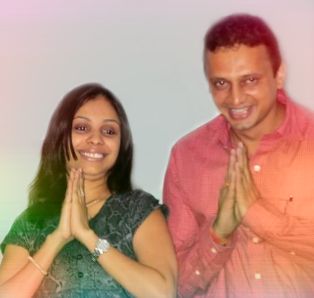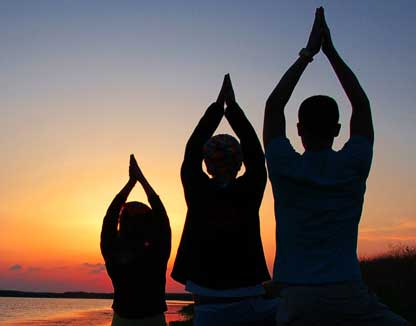 Namaste is placing the hands together in prayer and shows reverence to the Divine. Namaste is also the practice of greeting others and departing in silence when attending meditation groups or circles. It involves placing your palms together at the heart center, raising them to the third eye, then the chin as it is slightly bowed to the Divine within others. There may or may not be eye contact involved, depending how people feel at the moment of greeting or departing.
Namaste is placing the hands together in prayer and shows reverence to the Divine. Namaste is also the practice of greeting others and departing in silence when attending meditation groups or circles. It involves placing your palms together at the heart center, raising them to the third eye, then the chin as it is slightly bowed to the Divine within others. There may or may not be eye contact involved, depending how people feel at the moment of greeting or departing.
Namaste is the traditional way of greeting in India and Nepal. Everyone can say namaste. You can use namaste as in good morning, good night, thank you or welcome, and it can be used generously. The action of bowing the head and joining the palms of both hands together in front of the chest, over the heart, symbolises “I recognize the God in you”. It is the philosophy of oneness – You and I are One in heart and mind – opening the heart to spread love and peace, and the ability to offer our help and service to each other. Yoga is an exercise that brings all levels ofour existence, including the physical and intellectual, into balance. The gesture of namaste is yoga in itself, and many yogic activities begin and end with the performance of this deeply spiritual gesture. The practice of namaste with clear intentions develops faith in ahimsa – non-violence. Ahimsa Paramo Dharma – Ahimsa Paramo Dharma ––– Non—-violence is the greatest path.
Pranam Namaste – Traditional Yoga Practice
 Pronam (Namaste) is the joining of palms and bowing of the head in reverence and submission to God/Goddess. It is also offered in recognition that God/Goddess is supreme, and the refuge and protector of all. Pronam is also a traditional gesture in Hinduism for greeting and offering respect to guests and seniors and parting farewell to friends and others.
Pronam (Namaste) is the joining of palms and bowing of the head in reverence and submission to God/Goddess. It is also offered in recognition that God/Goddess is supreme, and the refuge and protector of all. Pronam is also a traditional gesture in Hinduism for greeting and offering respect to guests and seniors and parting farewell to friends and others.
Namaste or namaskar is the Indian way of greeting each other. Namaste and its common variants namaskar, namaskaara or namaskaram, is one of the five forms of formal traditional greeting mentioned in the Vedas.
Offering Pranam soothes and rejuvenates the body and mind. The feeling and intensity of respect and humility lingers and grows when practiced as a daily ritual. The essence of Pranam is obesance to the Divine. Devotees bow to God with humility and submission (Prantipat). The palms are held together at the heart center and the head bowed. This conveys deep reverence born from the heart and absolute submission of mind respectively.
God/Goddess as the Divine Creator, sustainer and destroyer, possess infinite powers. Pranam is gesture of appreciation of His/Her greatness and glory. It is also in recognition from the deep recesses of one’s mind and soul that God/Goddess is Supreme and the refuge and protector of all. Offering Pranam is offering one’s respect to the Divine One within other’s and seeking His/Her Grace and blessings for happiness in this world and beyond.
The other gestures of reverence to the Divine are Dandvat and Pradakshina. Prostrating and touching the eight specified parts of the body to the floor is called Shastang Dandvat Pranam and circumambulating the deity is called Pradakshina.
The ritual of Pranam is accompanied by a personal prayer to God. Offering Pranam soothes and rejuvenates the body and mind. The feeling and intensity of respect and humility lingers and grows with daily practice.
